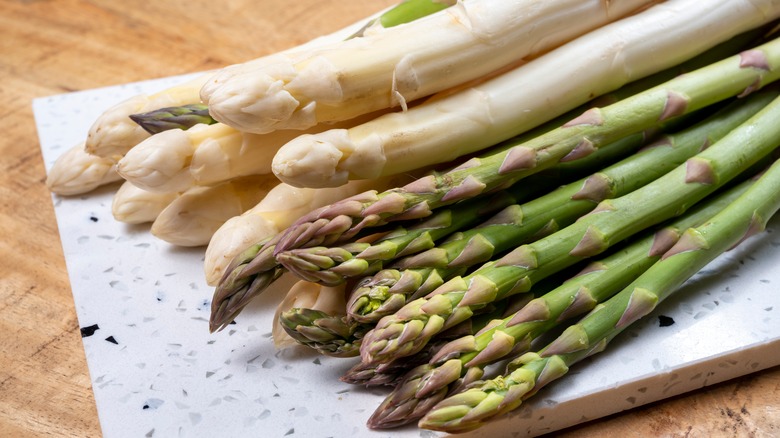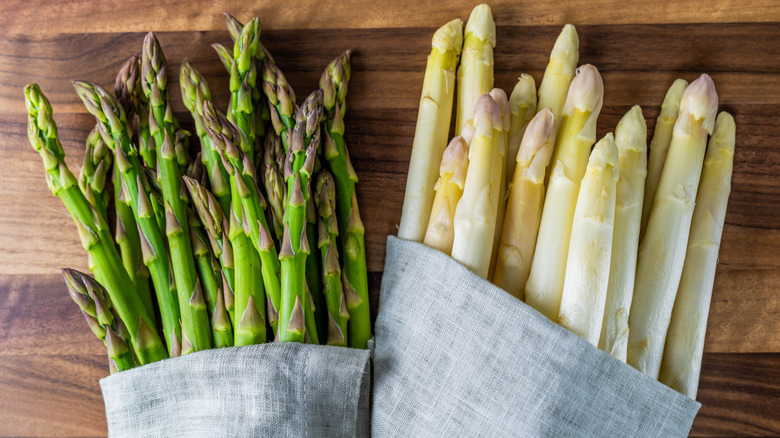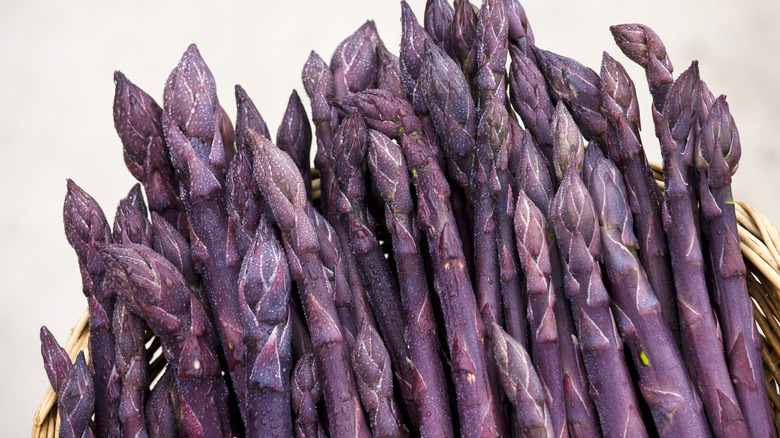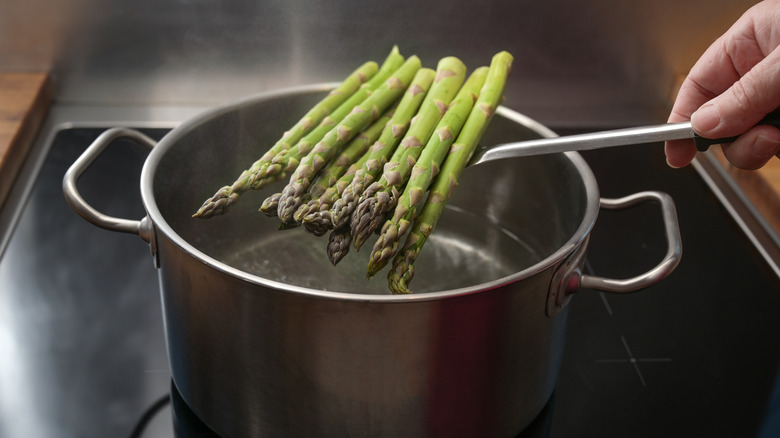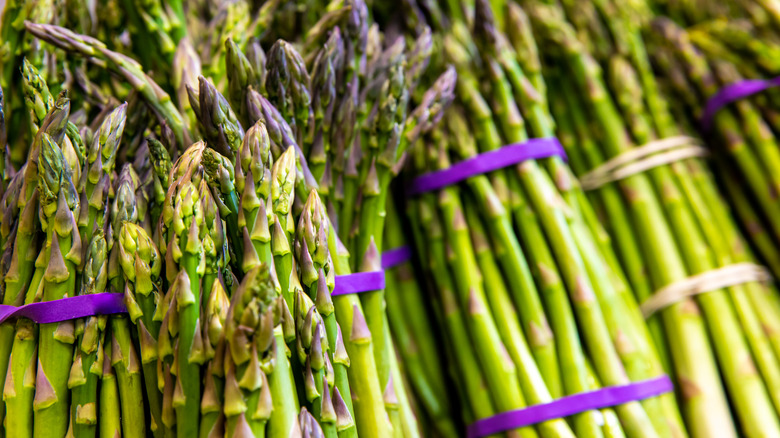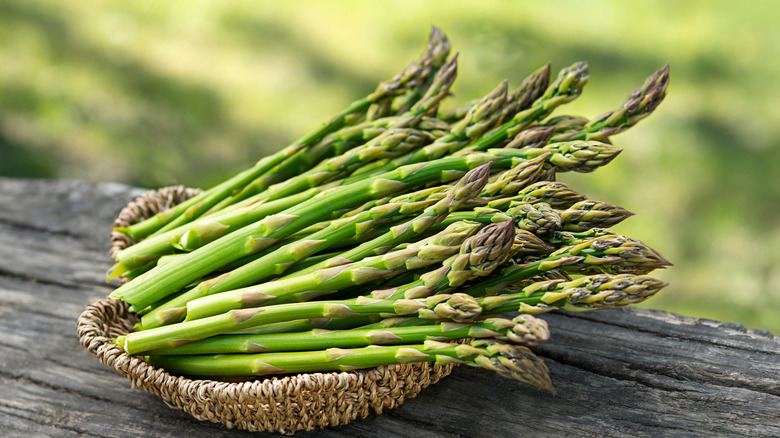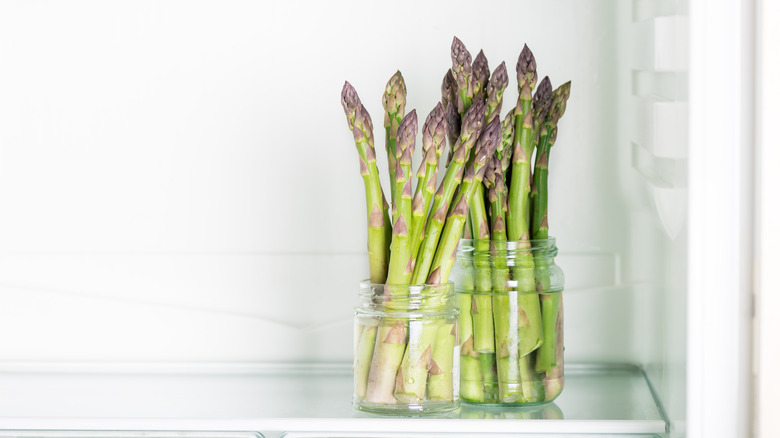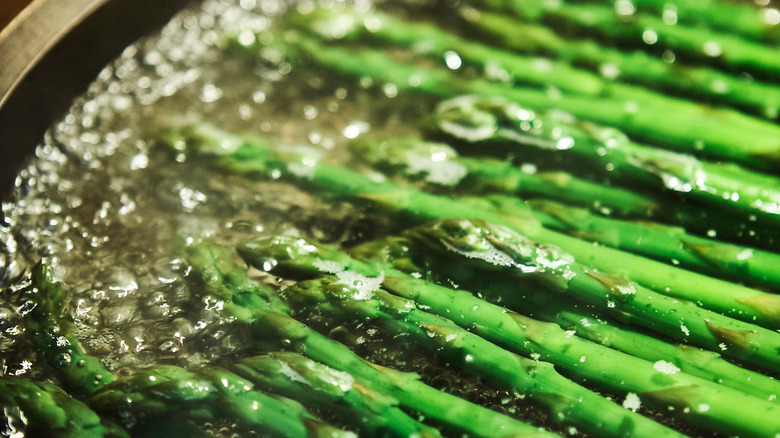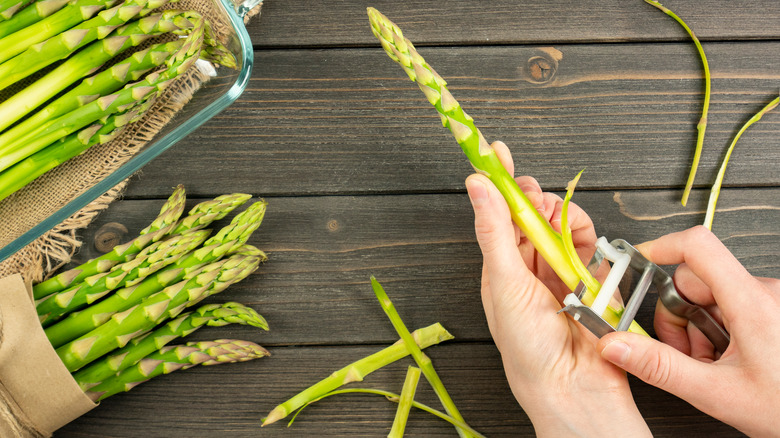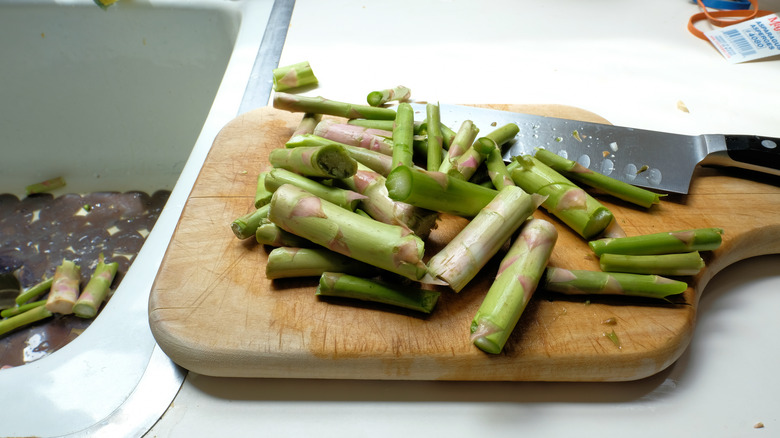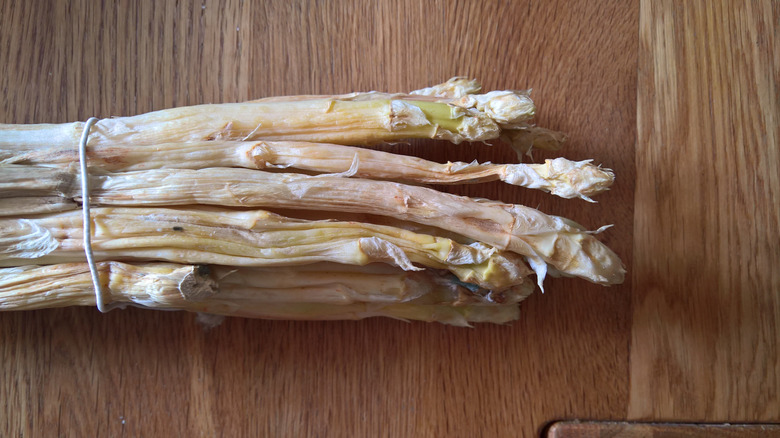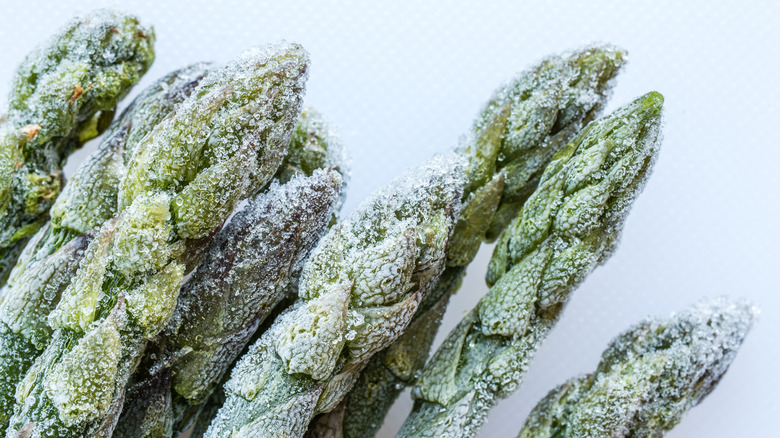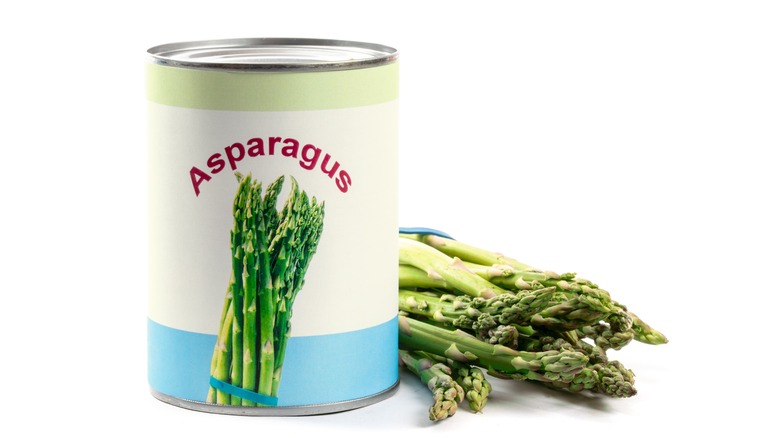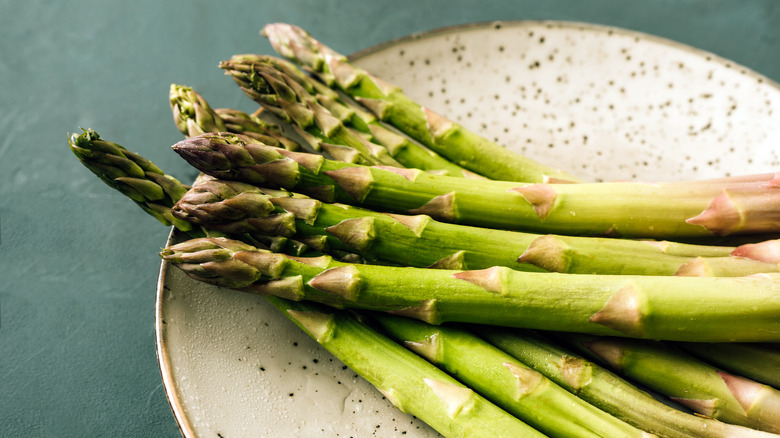14 Mistakes You're Probably Making With Asparagus
Can we all just take a moment to appreciate asparagus? This spear-shaped green vegetable is far from the most popular, but boy is it tasty. In the United States, people eat an average of two pounds of asparagus per year, compared to almost 19 pounds of tomatoes and over 20 pounds of onions. But this under-appreciated plant is one we should all be eating more of. Alongside its earthy, slightly nutty taste, asparagus is full of Vitamins C, E, and folate, has loads of fiber, can help keep your gut happy, and may even ease your head on a hangover.
Despite all of these good qualities, though, asparagus remains overlooked (maybe because of that unfortunate habit it has to make our urine smell a little funky). And because it's not as popular, it can also be easy to forget how to prepare it properly. Asparagus is one of those vegetables that's prone to messing up, either by choosing your bunch badly, poorly preparing the plant, overcooking your stalks, or storing them wrong. So, if you want to make those two pounds of asparagus some of the best veggies you eat all year, avoid these crucial mistakes.
1. Choosing a Bad Bunch
Making good asparagus starts with bringing home a good bunch from the store. But because it's a vegetable people buy less, it's easy not to be quite as aware of what asparagus that's in its prime look like. As a result, you can make the wrong choice, ending up with limp, faded asparagus stalks that have no snap to them.
It's important that you get to know what really good asparagus looks and feels like. Fresh asparagus shouldn't be wilted or slack and should feel sturdy and firm. The ends of the asparagus should look dense, and there shouldn't be any large gaps between the small needle-like leaves. As far as color goes, you should look for the most vibrant bunch you can find. Bear in mind, though, that asparagus can frequently grow with flecks or sections of purple, and while this can look like bruising, it may simply be the color of that specific plant.
The size of the asparagus generally won't give any indication of its freshness, but remember that buying especially thin asparagus may make it more prone to cooking quickly, and losing any crunch or snap. It's also worth trying to find asparagus that's all roughly the same size, to make your life easier when preparing it.
2. Not trying the different varieties
Asparagus, like all vegetables, comes in many different shapes, sizes, and especially colors. And if you're an asparagus rookie, one of the biggest mistakes you can make is not getting to know the different types that exist. You might be used to classic green asparagus, but its white counterpart is equally as delicious. White asparagus is grown without access to direct sunlight, meaning that it doesn't develop the greenness that the vegetable usually has. These chalky-white spears, which you might be more likely to find at farmer's markets, have a gentle sweetness and may not taste as grassy as green asparagus does.
Or, if you like your plate with a bit more color, try and find some purple asparagus. Pacific Purple and Purple Passion asparagus grows in deep violet and again tends to be sweeter than the green kind. Their purple color also indicates that they're full of useful antioxidants, making them even more healthy than the regular asparagus at your store. Importantly, these types of asparagus can lose their color if they're cooked too vigorously, so for maximum visual pop, serve them raw or steam-tender.
3. Not using your discarded stalks
Asparagus is one of those vegetables, like broccoli and cauliflower, where a lot of the stem can go to waste. It's generally prized for its more tender ends, but the base of the plant, which has a rough, dense, faded texture, is often thrown out. In some cases, a large part of the plant can then be discarded.
Next time, though, save those stalks and put them to good use. Asparagus stalks are full of flavor and, despite being commonly thought of as inedible due to their tougher texture, can be used as an integral part of a meal. A great way to utilize their goodness while simultaneously cutting down on food waste is by blending them into a soup. All you have to do is simmer them in some vegetable stock with some other aromatic veggies like onions, garlic, and whatever else you have to hand until everything's fork-tender. Then, whizz them up in your food processor, pour the soup into a bowl, and serve with a drizzle of olive oil and some fresh cream or Greek yogurt.
4. You're overcooking it
Nothing ruins asparagus more than overcooking it. This vibrant, firm vegetable can, in the wrong hands, turn into a droopy, lifeless sight. One of the joys of asparagus is the sweet spot where it's still firm but has a tenderness to it that makes it irresistible. And that sweet spot can be hard to find.
The key rule of thumb with asparagus is that you should probably be cooking it for a shorter amount of time than you think. Although it looks dense, the vegetable becomes soft fast, so you do need to keep an eye on it. For most cooking methods, asparagus only needs a few minutes, whether you're boiling it or cooking it with surface heat, like on a griddle. Steaming it, which cooks it using a gentler, slower-acting heat, may take a little longer, but your asparagus should be ready after five minutes or so.
The one exception to this is if you're roasting asparagus, which can take a little longer. But, even then, the plant should only take 10-12 minutes in a 400-degree Fahrenheit oven.
5. Forgetting to take the rubber band off
Do you know that rubber band that comes wrapped around each perfect bundle of asparagus stalks? Seems pretty useful, right? Seems like the kind of thing that you can probably just keep on until you're ready to use your vegetable ... Until you take it off after a few days, and realize that it's caused untold damage to the stalks.
Taking the rubber band off the asparagus is the first thing you should do once you get it home. The longer the rubber band stays on the asparagus, the more pressure it's applying to the central parts. And those central parts might seem sturdy, but as the asparagus gets older and starts to soften and wilt, this can turn the stalks into mush, bruise them, and make them taste bad and look even worse.
So, take the rubber band off, and allow your asparagus to be free. Or, if you're ready to use the asparagus straight away, put the band to use with a life hack. Roll it to the end of the bunch, and use it to keep the stalks in place, marking the place where you slice off the tough and woody ends. Doing this will keep your asparagus perfectly uniform, and stop you from having to do them one at a time.
6. Buying it out of season
In our non-stop, 24/7 world, we've got used to being able to get the produce we want, whenever we want it. But all vegetables have seasons when they're in their prime, and asparagus is no different. While modern farming and supply lines have made asparagus available year-round, buying it in season brings a host of advantages. Not only does buying seasonally ensure you get a fresher, better-tasting product, but it's also kinder to the environment, as the asparagus doesn't have to be shipped across the globe to get to your local store. As increased supply drives down the price of things, it'll also make your asparagus cheaper.
Asparagus season is in the first half of the year, specifically between February and June, which is why it's so popular in spring-time recipes. Its peak months are directly in the middle of spring, with April and May being the times when asparagus is the freshest and most harvested. Asparagus is unique as not a great deal else is seasonally available around these times. All the more reason to enjoy it while it's at its best, and make the most of it in your kitchen.
7. You're storing it incorrectly
It's always pretty incredible how quickly a firm green vegetable can turn into something flabby and faded. And not many vegetables can lose their luster as quickly as asparagus does, which makes correct storage of it essential. If you're buying your asparagus at peak freshness, you'll generally have 3-5 days before it's past its prime. If you're planning on eating it the same day you buy it, you won't have to do anything special to store it — but any longer, and it's useful to take action.
For asparagus that you're planning to eat in a few days, keeping it moist is crucial. Soak a paper towel in water, wring it out, and then wrap it around the asparagus, placing the bundle in a plastic bag or Tupperware. The moisture will help to keep it fresh and crisp. For longer-term freshness, you'll want to keep the stalks hydrated in the same way that you would a bunch of flowers. Trim off the ends of the stalks, and then place them cut-side down in a glass or jar. Pour a few centimeters of water into the vessel, and then cover the top of the bunch with a plastic bag. This will keep your spears well-hydrated and crunchy.
8. Forgetting to blanch it
As barbecue season starts to roll around, there are few things better to kick off the summer grilling than late-season asparagus. When grilled, asparagus develops a deep, smoky flavor that brings a whole new element to the fresh vegetable.
But grilled asparagus faces a big problem, and that problem is the speed at which the vegetable cooks on an open hot surface. If your grill is too hot, the asparagus can burn on its exterior before it has a chance to cook all the way through. And that's why you should blanch your asparagus before grilling it. Shocking the asparagus in boiling water for a few minutes before you place it on the grill starts the cooking process so that it can finish off on the piping-hot surface. Blanching also heightens the greenness of the vegetable, thanks to the heat working to redistribute air bubbles that get in the way of the colorful chlorophyll in the plant, bringing out its natural tones.
Blanching asparagus isn't just a good idea when you're grilling it, either. Any cooking method that involves applying high direct heat, like frying or broiling, will be improved by a quick dip in some boiling water.
9. Forgetting to peel it
A large number of vegetables can be peeled, but, if you think about it, we only routinely remove the skin from a few of them. Other than onions, carrots, potatoes, avocados, and squash, with most other veggies, we tend to just toss them straight in the pan or a salad.
But you should add asparagus to that list, folks. While asparagus doesn't strictly need to be peeled, doing so could mean that you have more of the vegetable to eat. Preparing asparagus by snapping off the tougher ends can leave you with tender tips, but a relatively small plant to then eat. Peeling the ends of the asparagus, though, can get rid of the tougher outside of the lower half of the plant, meaning that you ultimately get more food from the bunch.
When you're doing this, make sure to try and keep your peels thin, and just take the outer layer off each plant, to avoid whittling them down too much and losing all their body. It's also best to avoid peeling asparagus that's already quite thin, as you'll just end up with nothing left to cook.
10. Trimming too much off the ends
Asparagus is a pretty curious vegetable, as it can go from super-tender to super-tough, all in one plant. For this reason, it's usually prized for its easily-edible tips, and the fibrous, dense ends of the plants are commonly discarded.
But there's a tendency to get a little too enthusiastic with trimming the ends off and wind up getting rid of half of the vegetable. Sometimes, you don't even need to trim the ends off at all or only need to trim off a tiny bit. If your asparagus is especially thin or young, the ends might be soft enough to remain on the plant.
For larger asparagus stalks, however, trimming probably will be necessary. But, again, don't assume that you have to cut off the full body of the plant. You generally only need to cut around an inch or two off each stalk, which will usually leave you with much more asparagus than the traditional method of snapping them. If they seem tender enough, use the ends to make stock, soup, or even asparagus pesto, by cooking and blitzing them with nuts, Italian hard cheese, and oil. If they look tough, though, throw them out.
11. Using asparagus that's past its prime
We all do it. We get home from the store with armfuls of fresh food, ready to make some delicious meals. And then the working week explodes, you're suddenly on calls from morning to night, and you're surviving on take-out and hastily-prepared sandwiches.
When this happens, fresh produce is the first to suffer, and asparagus can turn from elegant to inedible fast. It's useful to know the warning signs of gone-off asparagus. The first thing you should look at is the tips of the plant, which will give the first clues of spoilage. If they look or feel soft, they're probably on their way to becoming beyond use in the kitchen.
As the vegetable starts to go off, the tips will darken, eventually turning black. The body of the asparagus will also start to deteriorate, losing its firmness and eventually turning mushy and slimy. All of this can be accompanied by a pretty gross smell. Alternatively, asparagus can also dry out and start to grow mold. If you notice any of these warning signs, throw out your product immediately and buy a new one.
12. Not preparing it properly for freezing
Asparagus is a great vegetable to freeze, not least because it allows you to enjoy the seasonal vegetable throughout the year. However, it's not as simple as just popping a fresh bunch in your freezer and hoping for the best. Trying to freeze asparagus without any prior preparation will cause it to perish, and when defrosting it you may end up with a mushy, unappetizing vegetable that has lost its appeal.
As frozen asparagus is less common than other frozen vegetables like peas or sweetcorn, your best bet is to do it yourself — and to prepare it correctly. You can do this by blanching it, which halts the enzymes in the vegetable that cause it to deteriorate. Simply place your asparagus in some boiling water for a few minutes, before shocking it with ice-cold water, which will stop the cooking process. Remember to take off the tougher ends of the plant before you do this. Then, dry them off, so that no excess moisture makes its way into the freezer, and then place them in a freezer bag, and the freezer. Make sure you write when you froze them on the surface of the bag, so you can keep an eye on when you should throw them out, usually after a year.
13. Buying it canned
We live in the age of ultimate convenience, and virtually anything can be canned. But just because you can (sorry, please excuse us), doesn't mean you should. A crucial mistake people make with asparagus is thinking that the canned version is just as good as the real thing. Fresh asparagus is usually better than the canned variety, thanks to the fact that you're consuming a newly grown, unprocessed food. Canned asparagus is also often high in sodium, which can have a preservative function. This can result in you eating a large amount of salt with your portion of veggies, somewhat negating their nutrient-rich qualities.
It's undeniable, though, that canned asparagus is a quick and easy way to enjoy the produce year-round. So, if you need your asparagus fix in the dead of winter, we'd recommend going for frozen instead. Frozen asparagus, especially when you freeze it yourself, is a great way to retain the full nutrition and taste of the vegetable, while avoiding the need for any preservatives to extend its life.
14. Forgetting you can eat it raw
Asparagus is most commonly envisioned being served tender and juicy, usually nestled on a plate next to a cut of super-healthy fish or some other vegetables. But raw asparagus is a joy on its own. Asparagus is perfectly edible when it's not cooked, provided it's soft enough to chew and swallow, and, as a bonus, you don't have to worry about cooking it to the perfect consistency. Fresh raw asparagus is a great snack on its own with a dipping sauce or sliced into a salad.
It might be advisable to prepare your asparagus before you eat it raw, though. If the stalks are tough, it's a good idea to peel the plant to get rid of some of the harder-to-eat skin. As with cooked asparagus, you'll also need to remove the ends, which will be too tough to eat raw. It's worth remembering, though, that cooked asparagus may be easier to eat all around, as it's softer. And, as a study published in the International Journal of Molecular Sciences points out, cooking asparagus may make it healthier, by raising its antioxidant activity.
